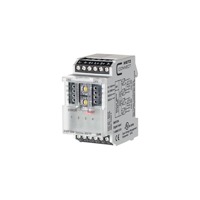Input Modules
BMT-DI4
The BACnet MS/TP module with 4 digital inputs was developed for decentralized switching tasks. It is suitable for detecting potential-free switch states, for example electrical limit switches on vent valves or auxiliary contacts of power contactors. The inputs can be operated by means of potential-free switches or contacts or used as voltage inputs. The inputs can be scanned by means of standard objects via a BACnet client. The module is addressed and the baud rate is set by means of two address switches on the front.
BMT-DI10
The BACnet MS/TP module with 10 digital inputs was developed for decentralized switching tasks. It is suitable for detecting potential-free switch states, for example electrical limit switches on vent valves or auxiliary contacts of power contactors. The inputs can be used as contact or voltage inputs. The inputs can be scanned by means of standard objects via a BACnet client. The module is addressed and the baud rate is set by means of two address switches on the front.
BMT-SI4
The BACnet MS/TP module with 4 S0 inputs to DIN EN 62053-31 class A was developed for decentralized switching tasks. It is suitable for counting S0 counter pulses. This allows very good integration of the module into an energy controlling system. In case of a power failure, the last counter readings are saved. The inputs can be scanned by means of standard objects via a BACnet client. The module is addressed and the baud rate is set by means of two address switches on the front.
BMT-AI8
The BACnet MS/TP module with 8 individually configurable resistance or voltage inputs is designed for local switching operations. It is suitable to record resistance or voltage values of for example passive and active temperature sensors electrical ventilation or mixing valves, valve positions etc. The inputs are universally configurable by standard object via a BACnet-Client. Addressing of the module and baud rate setting are done with the two address switches (x1 / x10) on the front. Possible settings are addresses 00 to F9 and baud rates 9600 Bd, 19200 Bd, 38400 Bd, 57600, 76800 Bd and 115200 Bd.
Output Modules
BMT-DO4
The BACnet MS/TP module with 4 digital outputs is designed for local switching operations. It is suitable to operate electrical components such as motors, contactors, lamps, sun-blinds etc. We recommend to protect the relay contacts additionally by a RC-element or high inductive loads. The module is provided with a manual control facility for manual switching of the relays. The outputs can be operated by standard objects via a BACnet-Client. Addressing of the module and baud rate setting are done with the two address switches (x1 / x10) on the front. Possible settings are addresses 00 to F9 and baud rates 9600 Bd, 19200 Bd, 38400 Bd, 57600 Bd, 76800 Bd and 115200 Bd.
BMT-AO4
The BACnet MS/TP module with 4 analog outputs was developed for decentralized switching tasks. It is suitable as encoder for control variables, for example for electrical vent and mixing valves, valve positions, etc. The outputs can be output by means of standard objects via a BACnet client. The module is addressed and the baud rate is set by means of two address switches on the front.
Mixed Input and Output Modules
BMT-DIO4/2
The BACnet MS/TP module with 4 digital inputs and 2 relay outputs with manual control was developed for decentralized switching tasks. It is suitable for accommodating, for example, light switches and window contacts in a room, switching two light strips or controlling louvers. It can also be used to control 2 motorized fire dampers. With strong inductive loads, we recommend protecting the relay contacts with an RC element. The inputs can be used as contact or voltage inputs. The inputs and outputs can be switched and scanned by means of standard objects via a BACnet client. The module address and the baud rate are set by means of two address switches on the front.
Power Supply
NG-4 Gray
The NG4 power supply supplies regulated direct voltages for supplying power to the respective devices of the product family of I/O components. The device supplies regulated direct voltage 24 V DC at a power of 16 watts. A parallel operation of several power supply units is not allowed. The secondary voltage can only be tapped at the right side of the plug connector and at the screw-type terminals on the top of the module. The bus communication is looped through on both sides of the plug connectors.



